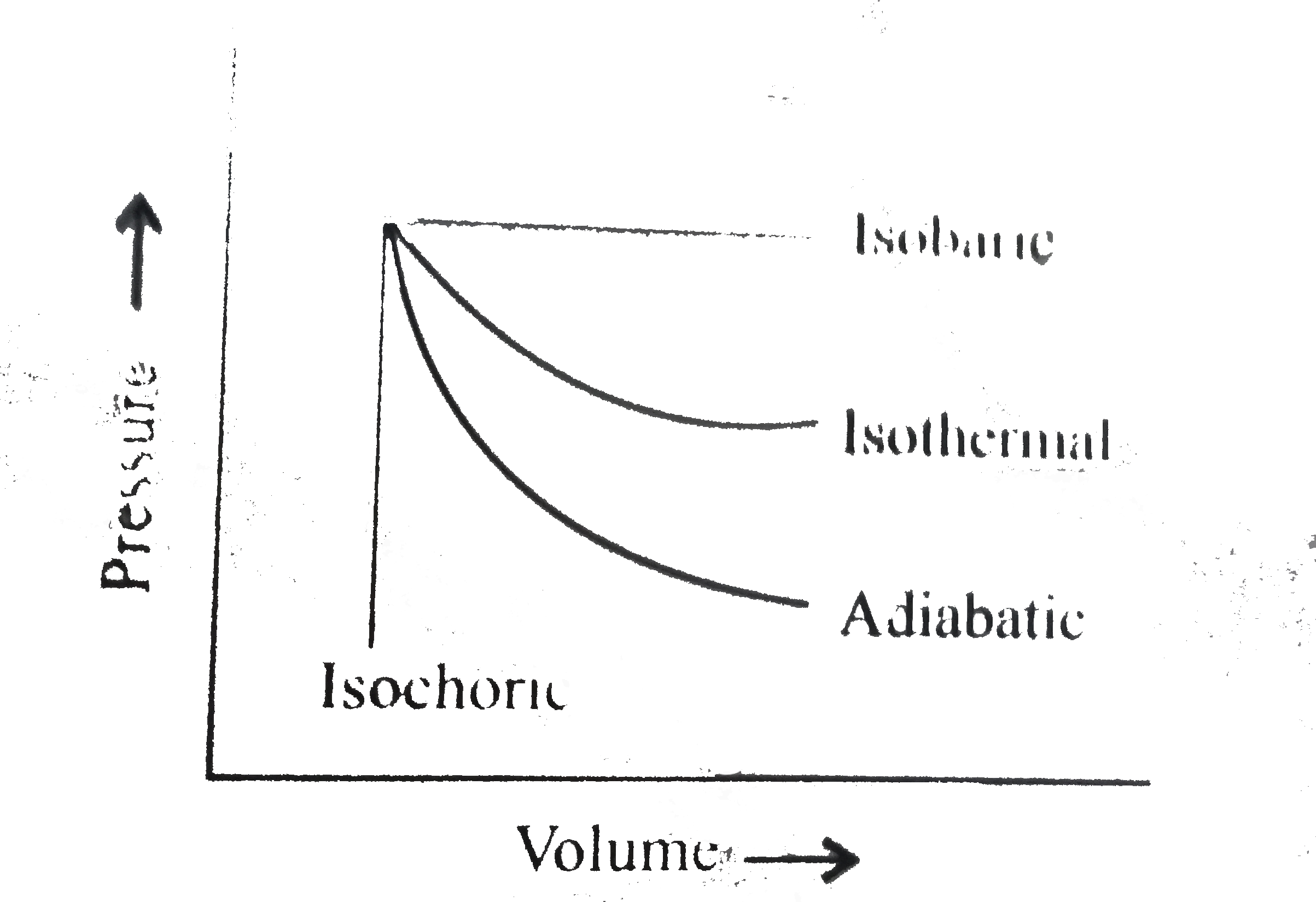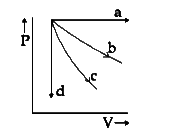If w1,w2,w3 and w4 for an ideal gas are magnitude of work done in isothermal, adiabatic, isobaric and isochoric reversible expansion processes, the correct order will be :
w1>w2>w3>w4
w3>w2>w1>w4
w3>w2>w4>w1
w3>w1>w2>w4
The correct Answer is:D
To solve the problem of determining the correct order of work done (W1, W2, W3, W4) for an ideal gas in various reversible expansion processes (isothermal, adiabatic, isobaric, and isochoric), we can follow these steps:
1. Understand Work Done in Different Processes:
- The work done (W) in a thermodynamic process is represented by the area under the PV (Pressure-Volume) curve.
- The types of processes we are considering are:
- Isothermal (W1): Constant temperature.
- Adiabatic (W2): No heat exchange.
- Isobaric (W3): Constant pressure.
- Isochoric (W4): Constant volume.
2. Analyze Each Process:
- Isothermal Process (W1): The work done is significant because the gas expands at a constant temperature, and the area under the curve is relatively large.
- Adiabatic Process (W2): The work done is less than in isothermal because the gas does not exchange heat with the surroundings, leading to a steeper curve.
- Isobaric Process (W3): The work done is the largest among these processes because the pressure remains constant while the volume changes, leading to a significant area under the curve.
- Isochoric Process (W4): No work is done since the volume does not change (W = 0).
3. Determine the Order of Work Done:
- From the analysis, we can conclude:
- W3 (Isobaric) > W1 (Isothermal) > W2 (Adiabatic) > W4 (Isochoric)
- Therefore, the correct order of work done is:
- W3 > W1 > W2 > W4
Final Answer:
The correct order of work done is:
W3 > W1 > W2 > W4
- The work done (W) in a thermodynamic process is represented by the area under the PV (Pressure-Volume) curve.
- The types of processes we are considering are:
- Isothermal (W1): Constant temperature.
- Adiabatic (W2): No heat exchange.
- Isobaric (W3): Constant pressure.
- Isochoric (W4): Constant volume.
- Isothermal Process (W1): The work done is significant because the gas expands at a constant temperature, and the area under the curve is relatively large.
- Adiabatic Process (W2): The work done is less than in isothermal because the gas does not exchange heat with the surroundings, leading to a steeper curve.
- Isobaric Process (W3): The work done is the largest among these processes because the pressure remains constant while the volume changes, leading to a significant area under the curve.
- Isochoric Process (W4): No work is done since the volume does not change (W = 0).
- From the analysis, we can conclude:
- W3 (Isobaric) > W1 (Isothermal) > W2 (Adiabatic) > W4 (Isochoric)
- Therefore, the correct order of work done is:
- W3 > W1 > W2 > W4
The correct order of work done is:
W3 > W1 > W2 > W4
Topper's Solved these Questions
Similar Questions
If w1.w2,w3 and w4 are work done in isothermal, adiabatic, isobaric, and isochoric reversible expansion for an ideal gas, respectively, then
View SolutionThe pressure-volume of varies thermodynamic process is shown in graphs:

Work is the mole of transference of energy. It has been observed that reversible work done by the system is the maximum obtainable work.
wrev>wirr
The works of isothermal and adiabatic processes are different from each other.
wisothermal reversible=2.303nRTlog10(V2V1)
=2.303nRTlog10(P2P1)
wadiabatic reversible=CV(T1−T2)
If w1,w2,w3 and w4 are work done in isothermal, adiabatic, isobaric, and isochoric reversible processes, respectively then the correct sequence (for expansion) would beView SolutionAn ideal gas expands from V to 2V in 4 separate processes. Where process 1 is isothermal process 2 is adiabatic, process 3 is free expansion and process 4 is isobaric. If E1,E2,E3 and E4 are the changes in average kinetic energy of the molecules in the isothermal, adiabatic free expansion and isobaric process respectively then choose the correct options.
View SolutionLet QandW denote the amount of heat given to an ideal gas and the work done by it in an adiabatic process.
View SolutionWork done in the isothermal reversible expansion of a gas is always greater than that done in isothermal irreversible expansion of the gas.
View SolutionThe given diagrams shows four processes i.e., isochoric , isobaric , isothermal and adiabatic. The correct assignment of the processes in the same order is given by:
 View Solution
View Solutionif work is done by the system then W is
View SolutionLet Q and W denote the amount of heat given to an ideal gas the work done by it in an isothermal process.
View SolutionCalculate the work done during isothermal reversible expansion expansion of one mol of an ideal gas from 10 atm to 1 atm at 300K.
View SolutionCalculate the work done during isothermal reversible expansion expansion of one mol of an ideal gas from 10 atm to 1 atm at 300K.
View Solution

